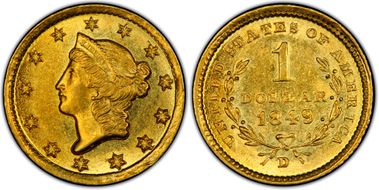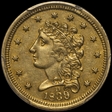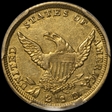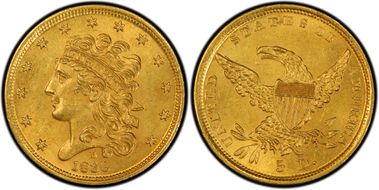billsnotes 的钱币相册
Although the Charlotte mint issued both quarter eagles and half eagles during its first year of operations in 1838, the Dahlonega mint didn't issue its first quarter eagles until the beginning of 1839. I have been unable to uncover a reason for this from the five reference books that I have on the subject. I suspect that the Philadelphia Mint, which produced all of the dies for the branch mints, did not send any quarter eagle dies to Dahlonega in 1838. Chief Mint Engraver, Christian Gobrecht, introduced his Liberty Head design to the half eagle in 1839. The was a delay in that introduction which met that the Philadelphia Mint only had Classic Head quarter eagle dies available for the branch mints. Therefore during the first part of the year, the Charlotte, Dahlonega and New Orleans gold coin production was limited quarter eagles only. Once the half eagle dies arrived, the two Charlotte and Dahlonega Mints initiated production of those coins. I have read that the Dahlonega Mint personnel disliked making quarter eagles because they had technical problems with them. Many pieces exhibit die breaks and die clashes which would have resulted in more downtime for repairs and adjustments. Also those who deposited gold for coinage at the Dahlonega Mint preferred half eagles to quarter eagles. Therefore the quarter eagle mintages at the Dahlonega Mint were small through the series. The 1839-D quarter eagle is a scarce and highly popular one year type coin. This was the only year that the Dahlonega mint issued the Classic Head quarter eagle design. Although the mintage was 13,675, specialist dealer, Doug Winter, has estimated that only 200 to 250 examples survive today. Among those survivors the most often seen examples grade in the VF and EF categories. This piece, which just barely meets the Mint State grade with an MS-60 is among the dozen or so pieces that qualify for the Uncirculated grade. The finest known examples of this coin are in MS-64.
Although the Charlotte mint issued both quarter eagles and half eagles during its first year of operations in 1838, the Dahlonega mint didn't issue its first quarter eagles until the beginning of 1839. I have been unable to uncover a reason for this from the five reference books that I have on the subject. I suspect that the Philadelphia Mint, which produced all of the dies for the branch mints, did not send any quarter eagle dies to Dahlonega in 1838. Chief Mint Engraver, Christian Gobrecht, introduced his Liberty Head design to the half eagle in 1839. The was a delay in that introduction which met that the Philadelphia Mint only had Classic Head quarter eagle dies available for the branch mints. Therefore during the first part of the year, the Charlotte, Dahlonega and New Orleans gold coin production was limited quarter eagles only. Once the half eagle dies arrived, the two Charlotte and Dahlonega Mints initiated production of those coins. I have read that the Dahlonega Mint personnel disliked making quarter eagles because they had technical problems with them. Many pieces exhibit die breaks and die clashes which would have resulted in more downtime for repairs and adjustments. Also those who deposited gold for coinage at the Dahlonega Mint preferred half eagles to quarter eagles. Therefore the quarter eagle mintages at the Dahlonega Mint were small through the series. The 1839-D quarter eagle is a scarce and highly popular one year type coin. This was the only year that the Dahlonega mint issued the Classic Head quarter eagle design. Although the mintage was 13,675, specialist dealer, Doug Winter, has estimated that only 200 to 250 examples survive today. Among those survivors the most often seen examples grade in the VF and EF categories. This piece, which just barely meets the Mint State grade with an MS-60 is among the dozen or so pieces that qualify for the Uncirculated grade. The finest known examples of this coin are in MS-64.
























